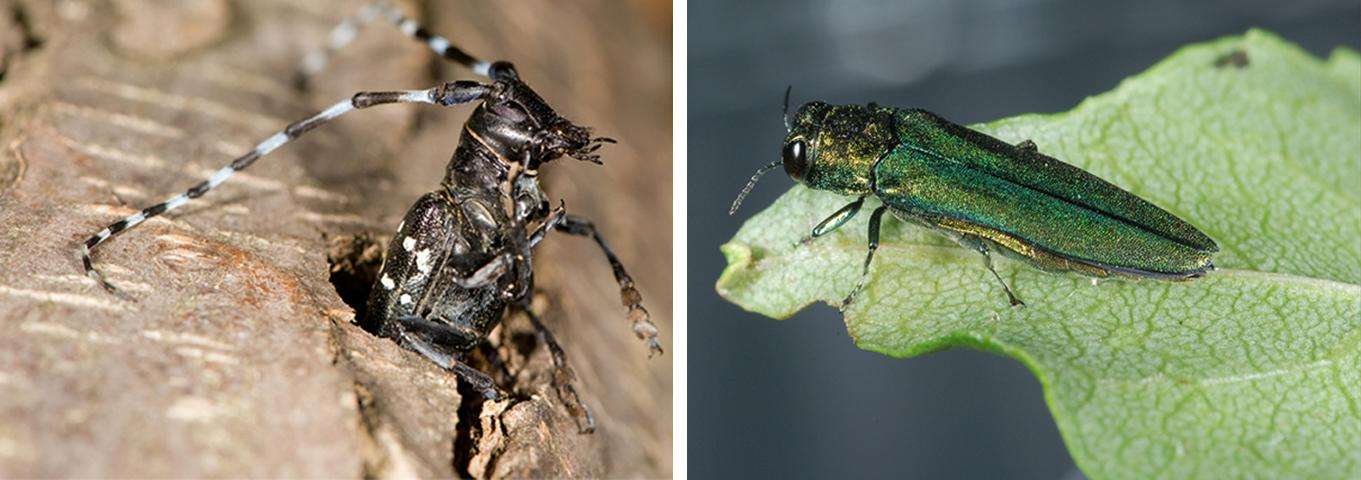Plant Protection Today: International Standards Reduce Pest Risk in Wood Packaging Materials

In New Scientific Paper, USDA Experts Assess the Success of International Standards
By Sharon Lucik
Wood packaging material (WPM) is a pathway for wood-boring pests that can harm forest and natural resources. And for this reason, more than 20 years ago, the International Plant Protection Convention (IPPC) adopted the International Standards for Phytosanitary Measures No. 15 (commonly known as “ISPM 15”) to help reduce the risk of moving wood pests in WPM in international trade.
Except for a foundational investigation published in 2014, this pathway and the impact of ISPM 15 on pests in WPM had not been studied in years.
That all changed with the publication of a new scientific paper in Frontiers in Forests and Global Change titled “Wood borer detection rates on wood packaging materials entering the United States during different phases of ISPM 15 implementation and regulatory changes.” Two co-authors with USDA’s Plant Protection and Quarantine (PPQ) program—National Identification Services Assistant Director Jesse Hardin and Phytosanitary Advanced Analytics Team member Barney Caton—collaborated with USDA Forest Service’s Toby Petrice and the original lead author of the 2014 paper, Bob Haack, now retired from the Forest Service.
“We evaluated Agriculture Quarantine Inspection Monitoring program data, which allowed us to estimate unbiased infestation rates over time,” said Hardin. “We found that introducing the ISPM 15 requirements did lead to significant reductions in the detection rates of wood boring pests. In fact, detection rates have remained relatively low while trade volumes have increased by 68 percent since implementation of ISPM 15.”
That’s good news because infested WPM intercepted at U.S. ports of entry are expensive for importers. These expenses can include storage (demurrage) charges while cargo associated with non-compliant WPM is safeguarded, and booking and shipping charges for re-exportation of the shipment. In addition, a lack of imported equipment and material can create production challenges or have costly impacts on time-sensitive projects.
The team identified other significant findings, including:
- Pest interceptions rates varied among commodities and exporting countries.
- WPM types—pallets, crating, or dunnage—contribute to pest detection. The highest detection rates were found in pallets, while crating had a higher-than-expected interception rate given its proportional usage.
- Almost half of the intercepted wood-boring pests were from the Cerambycidae family, (longhorned beetles), which were closely followed by Scolytinae subfamily interceptions (bark and ambrosia beetles).

There are more than 1.8 billion wood pallets in service in the United States each day, and billions more in circulation worldwide. For that reason alone, PPQ actively works through the North American Plant Protection Organization (NAPPO)—the phytosanitary standard-setting organization for North America. Through NAPPO, PPQ promotes ISPM 15 training, shares best practices, exchanges technical information, and helps other countries build their capacity to adopt and comply with ISPM 15. In addition, PPQ’s robust WPM website includes tools and resources about ISPM 15 compliance and accreditation for U.S. industry, importers, and WPM providers.
Today the United States and 80 other countries have implemented ISPM 15 regulatory measures, and compliant wood packaging materials have reduced the spread of wood-boring pests. As more countries adopt these international standards, and ISPM 15 compliance mechanisms improve, the hope is that pest incidences in these materials could diminish further over time.

